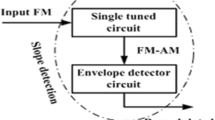Abstract
A mono-component AM–FM signal decomposition method is proposed using discrete second-order generalized integrator and phase-locking scheme. A discrete second-order generalized integrator (SOGI) is employed in the algorithm as a quadrature signal generator for a center carrier frequency. The outputs from SOGI are in-phase and quadrature components of the AM–FM signal. These components are processed in the discrete phase-locked loop to estimate instantaneous frequency variation and instantaneous amplitude variation. The estimated instantaneous frequency variation is fed back to SOGI to adjust the center frequency. Proposed mono-component AM–FM demodulator is implemented in FPGA platform. The algorithm offers good acquisition time, accuracy, and operating range. Experimental investigations performed on the algorithm prove the efficacy and suitability of the algorithm for mono-component AM–FM demodulation.


















Similar content being viewed by others
References
M. Ciobotaru, R. Teodorescu, F. Blaabjerg, A new single phase PLL structure based on second order generalized integrator. In: Proceedings of \(37^{th}\) IEEE Power Electronics Specialists Conference, PESC’06, 1–6
J.L. Flanagan, Parametric coding of speech spectra. J. Acoust. Soc. Am. 68, 412–419 (1980)
A. Francos, M. Porat, Analysis and synthesis of multicomponent signals using positive time–frequency distributions. IEEE Trans. Sig. Process. 47, 493–504 (1999)
A. K. George, P. Sumathi, Mono-component AM–FM signal decomposition using SRF-PLL. In: Proceedings of IEEE International Conference on Communication and Signal Processing, ICCSP 792-796 (2014)
E.B. George, M. Smith, Speech analysis/synthesis and modification using an analysis-by-synthesis/overlap-add sinusoidal model. IEEE Trans. Speech Audio Process. 5, 389–406 (1997)
K. Hermus, W. Verhelst, P. Lemmerling, P. Wambacq, S. van Huffel, Perceptual audio modeling with exponentially damped sinusoids. Sig. Process. 85, 163–176 (2005)
J.F. Kaiser, P. Maragos, T.F. Quatieri, Speech nonlinearities, modulations, and energy operators. IEEE ICASSP 1, 421–424 (1991)
P.J. Loughlin, B. Tacer, On the amplitude and frequency modulation decomposition of signals. J. Acoust. Soc. Am. 100, 1594–1601 (1996)
J.S. Marques, L.B. Almeida, Frequency-varying sinusoidal modeling of speech. IEEE Trans. Acoust. Speech Sig. Process. 37, 763–765 (1989)
K.V.S. Narayana, T.V. Sreenivas, AM–FM demodulation using zero crossing and local peaks. In: Proceedings on National Conference on Communication (2008)
A. Potamianos, P. Maragos, A comparison of energy operator and the Hilbert transform approach to signal and speech demodulation. Sig. Process. 37, 95–120 (1994)
T.F. Quatieri, T.E. Hanna, G.C. O’Leary, AM–FM separation using auditory-motivated filters. IEEE Trans. Speech Audio Process. 5, 465–480 (1997)
T.F. Quatieri, R.J. McAulay, Speech analysis/synthesis based on a sinusoidal representation. IEEE Trans. Acoust. Speech Sig. Process. 34, 744–754 (1986)
T.F. Quatieri, R.J. McAulay, Shape-invariant time-scale and pitch modifications of speech. IEEE Trans. Acoust. Speech Sig. Process. 40, 497–510 (1992)
P. Rodriguez, A. Luna, I. Candela, R. Mujal, Multiresonant frequency-locked loop for grid synchronization of power converters under distorted grid conditions. IEEE Trans. Ind. Electron. 58, 127–138 (2011)
P. Stoica, R.L. Moses, B. Friedlander, T. Soderstrom, Maximum likelihood estimation of the parameters of multiple sinusoids from noisy measurements. IEEE Trans. Acoust. Speech Sig. Process. 37, 378–392 (1989)
D. Vakman, On the analytic signal, the Teager-Kaiser energy algorithm, and other methods for defining amplitude and frequency. IEEE Trans. Sig. Process. 44, 791–797 (1996)
Author information
Authors and Affiliations
Corresponding author
Rights and permissions
About this article
Cite this article
George, A.K., Sumathi, P. Mono-component AM–FM Signal Decomposition Based on Discrete Second-Order Generalized Integrator Phase-Locked Loop. Circuits Syst Signal Process 36, 1604–1620 (2017). https://doi.org/10.1007/s00034-016-0380-x
Received:
Revised:
Accepted:
Published:
Issue Date:
DOI: https://doi.org/10.1007/s00034-016-0380-x




